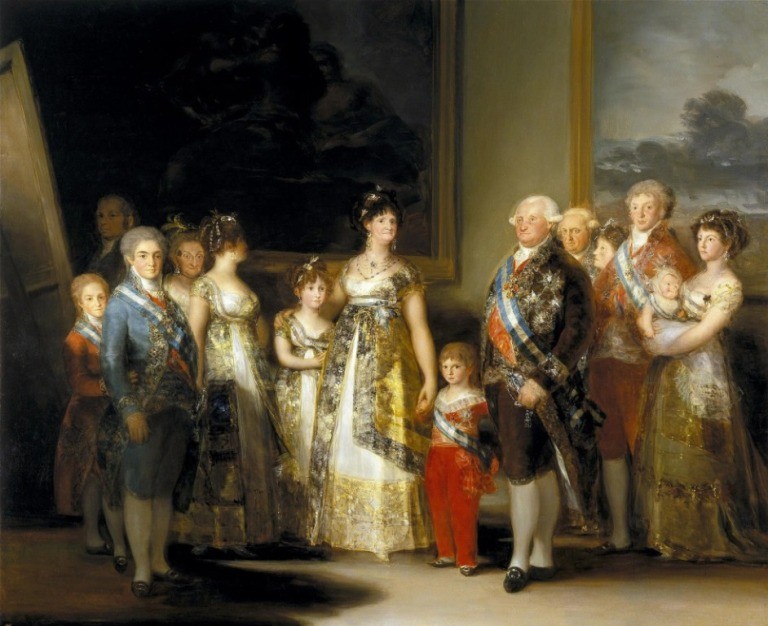Before us is the famous family portrait of the Spanish monarchs by the court painter Francisco Goya.
The overweight figure of the Spanish king Charles IV in a black jacket studded with orders, a wig and white stockings is shifted slightly to the right of the center of the picture. In the very center, the queen is depicted, his wife Maria Louise, which is not surprising: it was she, the domineering, voluptuous and cruel and her favorite Manuel Godoy, and not at all soft, weak-willed Karl, who owned the actual power in the country.
Next to the monarchs are their youngest children, the 6-year-old Infanta Francisco de Paula and the 11-year-old Infanta Maria Isabella. On the left is the 16-year-old Prince of Asturias, the future King Ferdinand VII (in the future, the aged Goya will find his reign too, and from his cruelty will flee to French Bordeaux, where he will meet death). The prince is dressed in a dark blue camisole and looks much more self-confident in the picture than his father, as, in fact, he was in reality. Behind the Infanta’s left shoulder, from the darkness of the background, like a nightmare from Goya’s etchings, the face of the elderly Infanta Maria Josefa, the queen’s sister, with a hooked nose and a sunken mouth appears.
In addition, on the left of the painting is the 12-year-old Infante Carlos Maria de Isidro, second in line to the throne after Ferdinand. So he is depicted: behind the heir No. 1. Who is the woman standing next to the infants and turning away from the audience is a mystery. On the website of the Prado Museum, she is referred to as “an unknown young woman.”
Behind the king is the 45-year-old infant Antonio Pasqual de Bourbon, brother of Charles IV, in profile next to him is the eldest daughter of the monarchs Carlota Joaquin, Queen of Portugal. To the right – 18-year-old Infanta Maria Louise, her son, baby Carl Luis and her husband Luis de Bourbon, the future king of Etruria.
“The Family of King Charles IV” is a ceremonial portrait, and at the same time, Goya’s irony is easily read in it. On the one hand, the Spanish rulers, present and future, are shown in a blaze of royal glory. Goya carefully reproduces their clothes, richly adorned with precious stones by the court jeweler. Women’s jewelry, orders of the king (among them – the recently established Order of Maria Louise and the Golden Fleece, as well as the Cross of the Immaculate Conception) – all this Goya writes out, it seems, with some special pleasure. The texture of fabrics is conveyed with no less taste and knowledge of the matter: heavy gold brocade, soft and smoothly matte velvet, light lace. However, the luxury of outfits only sets off the physical imperfections of the characters. According to the recollections, the king was phenomenally loose, and the libertine queen was completely ugly. And Goya does not seek to give them in an idealized form. He depicts not god-like crowned heads, but ordinary mortals of flesh and blood.
In democratic criticism, it will be customary to write about the family of Charles IV with almost disgust: spiritual squalor, bourgeois mediocrity, a family of shopkeepers, vulgarity, ignorance, degeneration, and so on and so forth. In Goya’s work they saw almost a caricature. It is unlikely that this is really so. Rather, we are dealing with a critical extreme. But Goya remained an artist, he created highly characteristic portraits, revealing in him an expert on human nature. And, by the way, the portrait was received favorably by the monarchs.
Francisco Goya said: “I recognize three teachers – Rembrandt, Velazquez and nature.” In this ceremonial portrait of King Charles IV with his loved ones there is a direct reference to the Velasquez Menin, the famous illusion painting, where, surrounded by royalty (the Infanta Margaret and the king and queen, her parents reflected in the mirror), the idol of Goya Velazquez work. Goya here unabashedly imitates Velazquez. In the same way, Francisco Goya inscribes a self-portrait in the group image of the family of Charles IV: in the darkened left corner, behind the royals, behind the easel, you can see the artist’s pensive face like Rembrandt.
Year of painting: 1800.
Dimensions of the painting: 280 x 336 cm.
Material: canvas.
Writing technique: oil.
Genre: portrait.
Style: romanticism.
Gallery: Prado, Madrid, Spain.
